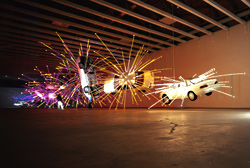Seattle Weekly: Which local artist, of any age or genre (apart from yourself), do you feel is the most underappreciated? Why?
“That’s about 99 percent of the artists in town. Almost no artist ever becomes a household name. It’s a tough life and a tough living. Artists are the most courageous people in this city—going to their studios every day, creating great work with so much financial uncertainty.” CATHERINE PERSON—Owner, Catherine Person Gallery
“Gretchen Bennett, Leo Saul Berk, Victoria Haven, Jenny Heishman, Yuki Nakamura, Alex Schweder, Robert Yoder, Dan Webb, Jaq Chartier, Scott Fife, Blake Haygood, Saya Moriyasu, Susan Robb, Cris Bruch, Annie Han and Daniel Mihalyo, Claire Cowie, Patrick Holderfield, Brian Murphy, Susan Dory, Sutton, Beres and Culler, and on and on. All of these are really good artists that deserve recognition.” DIRK PARK—Co-owner, Platform Gallery
What is your favorite local art space (other than your own)? Why?
“I think that Billy Howard and Jim Harris are running the best galleries in town. Two very good sets of eyes. Smart showmanship. Jim mounts some stunning shows in his small space. I think he uses that space more cleverly than most of us use much more space. Western Bridge is awesome, but it isn’t fully clear to me how it can serve the community fully.” GREG KUCERA—Owner, Greg Kucera Gallery
“Suyama Space offers the escape and room to actually contemplate the artwork that it contains. Also, it allows a single artist to install a single piece of work—that’s hard to come by.” ANNIE HAN—Designer, Lead Pencil Studios
“I have always liked the Frye Art Museum and the old Henry Gallery because those spaces are about the art rather than the architecture. . . . The Bellevue Art Museum is an example of a building that did not work to enhance the art. I must say they did make some improvements for the reopening.” LINDA HODGES—Owner, Linda Hodges Gallery
“Soil. Because they are always pushing the boundaries.” BOOTSY HOLLER—Photographer, Bootsy Holler Studios
What is the most interesting new trend in the Seattle art scene?
“The revitalization of Pioneer Square as the center of Seattle art making and exhibiting. Aqua Art Miami. Tashiro Kaplan [Artists Lofts] complex. Lawrimore Project. The expansion of Seattle Art Museum. Robin Held’s influence at the Frye. The SAM Sculpture Garden. Western Bridge.” DIRK PARK
“This one is awkward to answer since we [Lead Pencil Studio] are creatively intermingled in its formation, but I think Scott Lawrimore is about to embark on the most bold and interesting gallery model to hit Seattle in memory. Holds the potential to be a tangible bulwark for ambitious thinking on a national caliber.” DANIEL MIHALYO—Designer, Lead Pencil Studio
“It’s about time the city and county realized that artists are crucial to the cultural fabric. If the powers that be had taken steps to preserve cheap commercial space for the artists before their various landlords revoked it, they could have saved oodles and looked like heroes. The Tashiro Kaplan building is a godsend to one of the areas in town that really needed an infusion of 24-hour residents.” GREG KUCERA
“Tashiro Kaplan and the development of the eastern edge of Pioneer Square. It has created a strong and stable center for artists and galleries. It’s really great to be in close proximity. Aqua Miami Beach is the best new trend because it gives Seattle an opportunity to get the word out! I always think that homegrown, grassroots, DIY things are the most exciting.” BILLY HOWARD—Owner, Howard House
What’s the most worrisome new trend in local art?
“I worry that making work that is beautiful—beautiful in its own right—is no longer provocative enough to collectors or the media. Unless it’s glass, which is pretty much uncontroversial, I rarely see a review that [praises] the pure beauty of the work. With so much chaos and drama in the world, one would think that people would want to include beautiful work in their environments. But maybe because of the chaos, it is now taking unsettling or quirky work just to get people’s attention?” CATHERINE PERSON
“The artistic group hug, the community-based ethic that results in the seemingly endless stream of multi-artist themed showings. Supporting one another is fine, of course, but I long for a return of the artist as the eternal outsider, the enigma, the inscrutable bell chiming against the pummeling winds of reason.” JEREMY EATON—Graphic Artist/ Illustrator
“Charity art auctions, in their current execution, are problematic. It’s a love/hate thing. Such auctions increase the visibility of galleries and artists. They also raise money for good causes. The downside is that they reinforce bad art-buying habits and condition buyers to buy art in a rushed manner with the intention to get art on the cheap, often way below retail. This is counter to how art should be bought and experienced.” MICHAEL RIVERA-DIRKS—Owner, Viveza Gallery
“Seattle’s single biggest art liability is the exorbitant real-estate market which is pushing emerging artists to less expensive cities before Seattle has a chance to establish a potent voice in contemporary art. DANIEL MIHALYO
“The accelerated production of giant nutcrackers, pigs, deer, etc. that artists are asked to decorate and then are stuck on corners around town. I don’t get it. The cultural damage this trend can wreak should not be underestimated. (I fantasized about decorating a Nutcracker man in bondage leather.)” MOLLY NORRIS CURTIS—Artist/Director, Gallery 110
“That there isn’t a real trend, that we are not creating or maintaining an identity or focus that makes Seattle a destination for art.” CRISTA DIX—Owner, Wall Space
“Whenever it gets time to tighten the belt, people love to point to the arts and call the pittance of public money that is allotted for this wasteful. Seattle is a great city, but imagine this city without the museums, or public art. Imagine who we would be if public and private institutions quit teaching art. Who would come here and what kind of people would we be missing? Good ideas come from creative minds. One way to encourage creativity is to experience art. Art is not fluff, it is essential to a thriving society.” DAVID CHATT—Artist
“I wish [more artists] could afford to live in the city. [It’s] too expensive for housing and studio space. I have a feeling that we’re losing and missing some great young artists. I may just be paranoid. [But] I don’t think so.” JOHN BRASETH—Co-owner, Woodside/Braseth Gallery
“A more acerbic channel of arts criticism. A voice to cut away the chaff, disregard the familial and incestuous ties in our small community, and call it bad when it is indeed bad.” JEREMY EATON
What’s your most and least favorite piece of public art in Seattle? Why?
“Most: Adjacent, Against, Upon, Michael Heizer, Myrtle Edwards Park. Broad gestures work really well in public settings. And you can climb on it, just like the Fremont Troll! Least: Fremont’s Lenin statue. Not because he was a totalitarian mass-murderer, but because the neighborhood leaders thought it was a kinda cute, kitschy thing have around, and he was a totalitarian mass murderer.” ERIC FREDERICKSEN—Director, Western Bridge
“Favorite is the Calder Eagle [at Volunteer Park]. Calder is a sentimental favorite. He was the first famous artist whom I sold a piece by when I was a young dealer. I live by Volunteer Park, and I jog or drive by the piece every morning of my life just to nod and say hello. I wish it weren’t slated to be placed in the new sculpture park. It will be dearly missed in my neighborhood—imagine how Philadelphia felt when it flew away to the West Coast!” JOHN BRASETH
“What cruel and unusual punishment to ask for only one [least favorite]! Ten Feet Into the Future by David Govedare, near Myrtle Edwards Park. This aluminum sculpture of ‘five life-size joggers led by a Native American with an African American, an Asian, a Hispanic, and a Caucasian’ is so stilted and harsh to look at that I believe I have been emotionally damaged by living in the same city with it. I have to say a second place: the Seattle Fallen Firefighters piece [by Hai Ying Wu] in Occidental Square—50 percent gay bar, 50 percent saccharine. If they’d just gone all gay bar, it would be so cool!” MOLLY NORRIS CURTIS
What is the most overrated art institution in town and why?
“I am so appreciative of any institution which exists to promote the arts that I am uncomfortable criticizing them. That said, I think many individuals who fancy themselves as ‘experts’ do us all a disservice when they define art in too narrow of terms. Art is not a social club or some sort of test to see and show our level of education and expertise. Art should be for everyone. We will never be able to have the much-needed public support for the arts if we treat people like a bad smell when they walk into a gallery or museum. In general, I think institutions could do a better job of making art a part of everyone’s life and not something to be appreciated and enjoyed only by the moneyed and intellectual elite.” DAVID CHATT
“Could it be that none of them are overrated because no one expects enough of any of them? They often coast on predictability and comfortableness. The best and most underrated art institution in town? Artist Trust. No institution has done more for the artist in this town. Period.”—GREG KUCERA
Miscellany . . .
“I was at an event last night walking around with a very important museum curator, and the artists there didn’t even know who she was or even try to make an introduction. That’s frustrating—you never know who’s going to pop in to your studio. The game is on! All the time! Best lesson here is that you have to hustle to get recognized. There is a comfort level in Seattle that artists get into and I hate that more than anything. If they don’t push to get their work out and make connections with the people who are in the business, it’s their own fault. Rejection is a huge part of making it. Eventually, if the work is good, someone will recognize it, but you have to put your neck out to get noticed.” BILLY HOWARD—Owner, Howard House
“I actually think the art scene in Seattle is still resting on the shoulders of the old icons—Gaylen Hansen, Fay Jones, Sherry Markovitz. They’ve been doing what they do for such a long time, they’ve become institutions that overshadow or obstruct any new light.” DEL WEBBER—Artist







